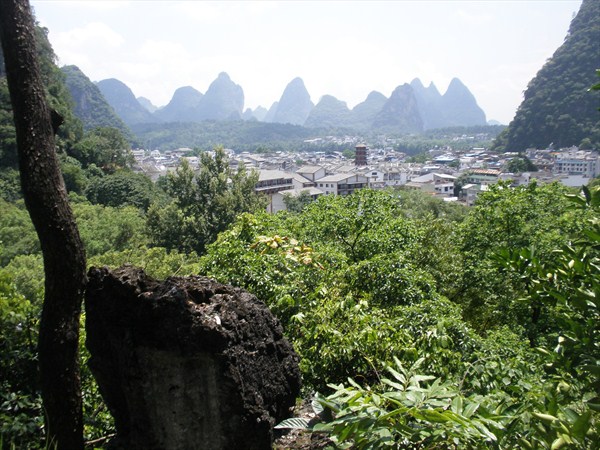Yangshuo - GE9 EarthCache
-
Difficulty:
-

-
Terrain:
-

Size:  (not chosen)
(not chosen)
Please note Use of geocaching.com services is subject to the terms and conditions
in our disclaimer.
This earthcache is placed on the hill in the center of Yangshuo with a beautiful view.

The karst geomorphy around Yangshuo is an area of irregular limestone formations in which erosion has produced fissures, sinkholes, underground streams, and caverns. This is wide-spread in the region, creating numerous natural scenic spots. Around the river Li we can found over 70,000 karst peaks, called also mogotes - isolated, steep-sided, residual hills surrounded by nearly flat plains
Karst Formation History
Two crustal movements of the earth took place about 200 and 180 million years ago thrusting the limestone sediments out of the sea from its bottom to form a large expanse of land. Through many years of erosion by the wind and rain the karst formation became the hills and rocks with unusual shapes.
Main dissolution mechanism
Karst landforms are the result of mildly acidic water acting on weakly soluble bedrock such as limestone or dolostone. The mildly acidic water begins to dissolve the surface along fractures or bedding planes in the limestone bedrock. Over time, these fractures enlarge as the bedrock continues to dissolve. Openings in the rock increase in size, and an underground drainage system begins to develop, allowing more water to pass through the area, and accelerating the formation of underground karst features.
The carbonic acid that causes these features is formed as rain passes through the atmosphere picking up CO2, which dissolves in the water. Once the rain reaches the ground, it may pass through soil that can provide much more CO2 to form a weak carbonic acid solution, which dissolves calcium carbonate. The sequence of reactions involved in the limestone dissolution are the following:

This is the main dissolution mechanism of calcium carbonate in limestone.
Here was the end of my listing, but reviewer asked me to describe what happened here in my words – just for kids, not for scientest. Good idea, I had really problem to write it. So here is my attempt.
In the beginning there was a huge limestone plate. Like a chocolate table on the desk. There are movements of tectonic plares in the earth’s crust and the table was broken to pieces. Imagine the table of chocolate divided to pieces as if you want to eat it.
Next the water from rain and rivers come. If you put water on chocolate it will start to dissolve it and flow parts of it away. The holes and openings become bigger and after some time most chocolate is out. The same as here. The rests of limstone’s plate are karst hills and mogules of different shapes.
You can ask why the water did not make a deep canyon - the bedrock is too hard. The water took the chocolate, but the desk remained the same. The end of the story is sad – after some time there will be no chocolate at all. But here in Yangsho it is a question of many milion years.
To claim the earthcache you have to climb to the top of the hill. There you can see several large stones from the same material as the hills around. Send me via profile answers to this questions:
1) What is the name of the rock (material, not hill)?
2) Do you see any holes in the stones? (none/few/many)
3) How many separate rocks you can see?
4) Can you estimate how thick was the "chocolate table"?
这个earthcache坐落在有着美丽景色的阳朔中心的山上。
阳朔附近的喀斯特地貌是一个不规则的石灰岩地区形成的腐蚀而产生的裂隙、落水洞、地下河流和洞穴。这是遍布了整个地区,创造了很多自然风景区。在漓江的周边,我们可以发现超过7000座喀斯特峰,也称作孤立的,陡峭的,残丘几乎被平原包围。
喀斯特的历史
大约200到180百万年前地球的两个地壳运动将石灰岩沉积物从它的底部冲出大海形成了一大片土地。经过很多年风雨侵蚀的喀斯特形成了奇形怪状的山和岩石。
岩溶的主要机理
喀斯特地貌是由于弱酸性的水作用在弱可溶性基岩如石灰岩或白云岩上形成的。弱酸性水沿裂缝或层理面在石灰石基岩开始溶解表面。随着时间的推移,这些裂缝扩大为基岩继续溶解。在大小的岩石增加开口,和一个地下排水系统开始发展,让更多的水通过面积,加快地下喀斯特地貌的形成。
碳酸导致了这些特征的形成因为雨通过大气层捡取了溶解在水里的CO2。雨一到达地面时,它通过土壤提供了更多的CO2来形成溶解的碳酸钙的弱碳酸溶液。参与石灰石的溶解反应的过程如下:

这是石灰石中碳酸钙的主要溶解机制。
我对卡斯特地貌的形成机理描述到此结束,但很多人希望我能更形象一点,以便孩子也能看懂,而不仅仅是科学家。好主意,不过这对我来说有一点难度,下面我就尝试一下。
在开始的时候,有一个巨大的石灰岩板,就像桌上的一块巧克力。这是在地球的地壳运动和构造的时候,平底层被打碎。想象一下这个巧克力里被分成了很多块,而且你想吃它。
下一步,雨水和河流中的水来了。如果你巧克力放到水中,你会发现巧克力将被水逐渐溶解成很多小块。巧克力里上的缺口越来越大,最终会被完全溶解。与此类似,石灰岩最终也会被溶解并形成奇形怪状的卡斯特地貌。
你可以问为什么水没有溶解出一个很深的峡谷,因为这里的基岩太坚硬了。这和水把巧克力溶解了,但是桌子依然在那儿类似。故事的结局是可悲的——对于巧克力,只需要一段很短暂的时间就可以完全溶解,但在阳朔,溶解这些石灰岩却需要上百万年的时间。
要拿到这个Earthcache,你必须等上山顶。在那里你可以看到几块和周围山峰上的岩石材料一样的岩石。把下面问题的答案通过电子邮件发送给我:
1)你看到的是什么岩石(回答岩石的类别)?
2)你在这些岩石上是否看到很多洞?(没有/少数/很多)
3)你可以看到多少块独立的岩石?
4)请估计这块“巧克力”的厚度?
Additional Hints
(No hints available.)